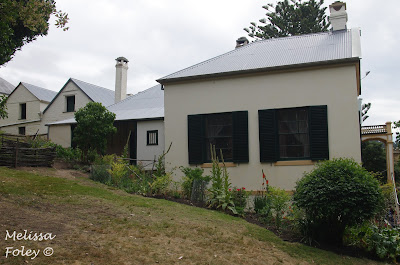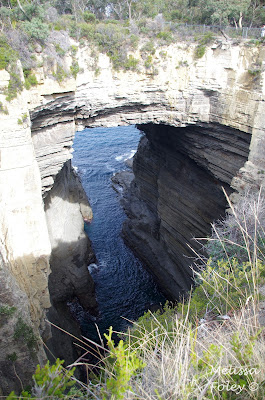When we moved to NZ, we shuffled our travel list a bit to take advantage of our new home base. Near the top of the list was Tasmania, a close neighbor across the Tasman Sea. Tasmania is a state of Australia, but the 150 miles separating it from the mainland give it an entirely different feel than the places we have visited in eastern and southern Australia. And there are way fewer things that want to kill you, which is always a bonus!
We started our trip in Hobart, the main city in Tassie. The quiet, lovely city was a nice change of pace from Auckland. We walked through historic neighborhoods, explored the waterfront, visited the museum, experienced the vast Salamanca market, and tasted the wide range of wines produced in Tassie at a local cellar door. We also happened upon CSIRO and the University of Tasmania's marine lab. While we were checking out an autonomous underwater vehicle in the window, the security guard motioned us into the building and let us check out the art exhibits on display. If either place called us up tomorrow and offered us jobs, we might have to move...
connections within a food web, lit with black lights
mermaid headphones?
Hobart waterfront
one of the many pier buildings that have been
transformed to markets and eateries
beetle collection at the museum
veggies at Salamanca Market
the market stretched as far as the eye could see
From Hobart, we drove southeast to the Tasman Peninsula, where the former convict colony of Port Arthur was located. In the 1800s, jails in England were filled to capacity so the government started giving people a sentence of "transportation," which meant they spent seven to eight months on a ship headed for Australia. Once there, they would serve the rest of their sentence at a convict colony. Port Arthur was generally reserved for hardened criminals with long rap sheets, but there was also a boys prison that housed kids as young as nine years old. Like Alcatraz in San Francisco, Port Arthur was considered a place that was impossible to escape. The bush was thick and disorienting and the ocean cold. And if anyone made it to the narrow isthmus connecting the peninsula to the rest of Tassie, they would have been met by a dog line. There were many escape attempts but no known successes.
At the Australian convict sites, they were trying a different approach to corporal punishment. They believed that all convicts could be reformed with discipline, hard labor, and religion, enabling them to re-enter society as functioning members at the end of their sentences. They also kept the worst prisoners separate from everyone else until they could be trusted. At Port Arthur, the convicts mainly logged the nearby forest, built ships, and produced bricks. The more obedient convicts were taught specialized trades, while the less compliant were relegated to chain gangs. The shipyard closed down in the 1840s when there was no longer a need for convict-built ships. Private ship builders lobbied the government to close the convict ship yards because they could not compete against the free convict labor. Convict transportation to Tasmania stopped in 1853 and Port Arthur closed in 1877.
the remains of the penitentiary
the interior of the penitentiary
one of the solitary cells in the penitentiary -
it is about four feet wide by seven feet long
hallway to the solitary cells in the separate prison
posh individual cells in the separate prison
separate outdoor recreation yards
remains of the church where 1100 convicts
would be crammed in every Sunday
Pademelon taking a nap
the Commandant's house was quite a contrast to the prison
the guard tower
The Tasman Peninsula also has a number of spectacular geologic features. It has the highest seaside cliffs in the country and has a series of limestone structures along an erosion trajectory.
the blowhole is slowly being carved out by the sea
Tasman's Arch has been extensively eroded,
but the ceiling of the arch remains intact
at the Devil's Kitchen, the arch ceiling has collapsed,
leaving the sheer cliff faces completely exposed to
the power of the Southern Ocean.
Next on the itinerary was Cradle Mountain National Park, a gem in Tasmania's northern wilderness. The wilderness is vast and accessing much of it takes days of hiking. We opted to stay in the front country since we only had a couple of days to explore. We arrived in the late afternoon and took the park shuttle bus to the end of the road. The crowds had mostly dissipated for the day so we had the trail mostly to ourselves. We hikes along alpine lakes, through meadows of button grass, and across boardwalks through eucalyptus forest. On our first hike we crossed wombat, echidna, copper skink, currawong, and tiger snake off the list of fascinating megafauna.
the parks namesake, Cradle Mountain
Banksia - the botanic garden at UCSC has many of these;
this was the first time I'd seen one in its native habitat.
the mighty wombat - these guys can run up to 40 km/hour!
boardwalk through the eucalyptus forest
button grass
An echidna taking a break from foraging for ants to scratch.
This is one of two monotremes (mammal that lays eggs) in the park.
Habitat zonation - the trails are made my wombats
tiger snake - one of the things that could kill us in Tassie
Currawong - they are very distantly related to crows and ravens,
despite their similar appearance. We had a flock of them outside
our tent one morning looking for insects and squawking like crazy.
It was nearly 100 degrees fahrenheit for our second day of hiking, but we got an early start and tried to stay in the shade as much as possible. We hiked through three quite different habitats, which were all really interesting. Our first hike was around Dove Lake, giving us views of the mountains and close-ups of the vegetation. Our second hike was through a pencil pine forest, a native to Tassie, and the third was through Dove Canyon, including an epically steep section of trail that was nearly vertical. We took a rest after that hike to hear a ranger give a talk on Tasmanian wildlife. It was thoroughly entertaining (he had written poems about many of the critters) and it was nice to sit inside an air conditioned building to cool off. Our final hike was a short jaunt around a creek that commonly has the second monotreme, the platypus. We must have good good platypus karma because I spotted one and Pete saw it before it disappeared. We had a similar experience 12 years ago when we saw our first one on the mainland.

an old boathouse on the lake
Dove Lake with Cradle Mountain in the distance
yellow-tailed black cockatoo - we heard
them long before we saw them!
Pencil Pine waterfall
steep trail through the canyon
the boardwalks were impressive!
another echidna - such interesting critters!
Our final adventure at Cradle Mountain was a visit to the Tasmanian Devil Sanctuary. We did see a devil in the wild - unfortunately, it was dead on the side of the road (we counted 31 animal carcasses on our 93 km journey!). Our chances of seeing a live one were incredibly low, so we opted for the Sanctuary. Tasmanian devils are the largest carnivorous marsupial remaining in Australia. The Thylacine - or Tasmanian tiger - became extinct in 1936. The devils nearly met a similar fate, but they managed to make a comeback after the bounty on their heads was lifted. They are still struggling, though, due to a relatively new disease to hit their population, Devil Facial Tumor Disease (DFTD). It is a communicable face cancer that spreads through the population when a healthy devil bites an infected devil. Communicable cancer is rare, but because their population was so small in the early 1900s, the devils are so genetically similar to one another that the cancer spreads between individuals. Scientists are working frantically to find a treatment for the disease, and the sanctuaries have been establishes around the country in the mean time to support a population of devils without the disease.
Devils got their name because of the screaming sound they make to communicate with each other. It is a load, shrill sound. I can imagine as a new settler to Tassie that the sound would have been a bit unnerving. They were hated by farmers because they thought the devils killed their livestock. It is likely the devils fed on the carcasses, but there is little evidence to suggest they could take down healthy animals. People were also afraid that the devil's would attack them, but the devils are quite shy and tend to hide from people. And they are incredibly cute!
an 8-month old devil
so much cuteness!
This is a three-year old male. The bites on his face are
from mating time. Devils fiercely protect their ladies to
ensure their genes get passed on to the next generation.
The facial biting is how DFTD is transmitted between devils.
my, what big teeth you have!
The sanctuary also raises eastern and spotted quolls, two other species of carnivorous marsupials that are also in trouble. The quolls are fascinating. They are ambush tree hunters and can take down prey five times their size! Once they kill their prey, devils are often attracted to the kill and steal the quolls lunch. Quolls don't get DFTD but their habitat is rapidly disappearing, putting their populations in jeopardy.
female spotted (tiger) quoll
male eastern quolls in two color morphs
We had the best weather while at Cradle and felt so fortunate because the day we left the temperature had plummeted and the rain had moved in. We packed up the tent in between thunderstorms and headed east to our final stop in Launceston. We didn't have a plan for the day so decided to detour a bit to a place called Woolmers Estate. We had no idea what the place was all about; we just knew it was a place of world heritage. It turned out to be another one of the world-heritage listed convict sites (Port Arthur was also one). Woolmers, however, was a completely different place. The estate was owned by Thomas Archer, who obtained the property in the early 1800s. To entice people to settle in Tassie, the government was giving away 800 acre blocks of land, complete with soldiers and convicts. The landowner had to feed, house, and provide religious instruction to the convicts in exchange for their labor. Like at Port Arthur, the convicts learned valuable skills that would increase their chances of employment after they received their ticket of leave. Archer treated his convicts so well that many of them stayed on after their sentences ended to work as free men. The estate stayed in the family through six generations of Archers when the last Thomas Archer died without an heir. He gave the estate and all its contents to a family foundation and required that it never to sold and become open to the public. It was really interesting to see the difference between the two convict sites.

The kitchen with the servant quarters above.
Woman convicts were also sent here.
The wool shed - the oldest surviving shed in Australia
some of the convicts wrote their names on the walls of the wool shed
the veranda of the family house
the main house
the church turned apple processing area
The "man cave." A flag was hoisted when they
needed the servants to bring more cigarettes.
the rose garden stands where the apple orchard used to be
Tasmania was great, but we definitely timed the weather well for our trip. The high was 50 degrees F the day we left.




































































